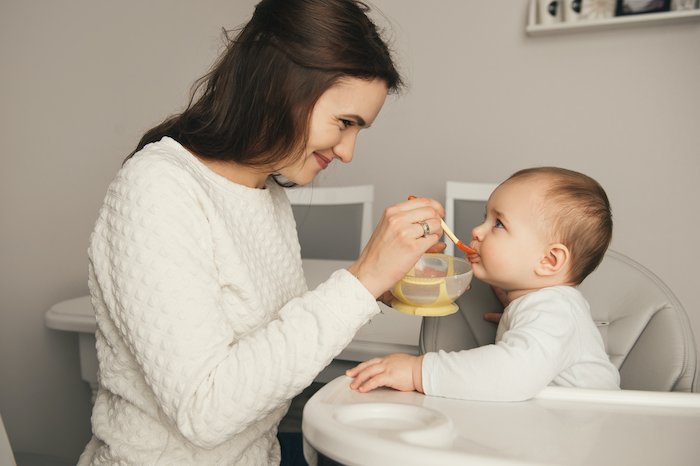
Most new parents make plans and plans and plans and prepare for lots of things when a baby is on the way: a birth plan, a sleep strategy, a feeding plan, and so on. We know that new moms are often looking for 2 things: control and confidence. And while there are a lot of unknowns in the first year, there are a few things you can plan for. A food allergy protection plan is one plan parents can take seriously, and master successfully, with just a few key changes based on what we know today. An ideal food allergy protection plan should be based on 3 key points:
- Early Introduction
- Diverse Diet
- Routine Feeding
Early Food Introduction
The American Academy of Pediatrics recommends starting your child on solids between 4 and 6 months of age. In a reversal from decades of advice from pediatricians to avoid the foods associated with food allergies, research now shows early and regular dietary exposure to a food — especially foods often associated with allergies, like peanuts — helps reduce the risk of a child developing an allergy to that food. Waiting too long to introduce and regularly feed these foods, research shows, increases the allergy risk.
Your job: Introduce common allergens (e.g., egg, peanut, fish, shrimp, sesame) just as you introduce fruits and vegetables. Help your baby love and enjoy and tolerate all of these foods!
Diverse Diet
Eating a diverse diet with multiple allergenic foods may reduce the likelihood of a food allergy by over 90%. Two landmark studies – LEAP and EAT – found that an infant’s risk of developing a food allergy dropped significantly when they were introduced to a potentially allergenic food early (as early as 4 months of age) and maintained inclusion of that food through early childhood.
Further research found that introducing young infants to multiple allergens at once was safe. The EAT study showed that 98% of babies who were fed foods like peanuts, sesame, eggs, fish, and dairy by five months of age and who kept those foods in their diets regularly did not develop a food allergy.
So make sure you’re offering your little one lots of different types of foods.
Routine Feeding
Consistency is key. Intermittent or “one bite” exposure to foods may not be enough to protect babies. Like any great habit (think toothbrushing), research shows the immune system works best when it’s exposed to a wide variety of foods regularly throughout a child’s early years. Scientists believe regular, consistent exposure to common allergens in the diet throughout early childhood is key to staying healthy. You can use this guide to talk with your pediatrician about our evidence-based approach to food allergy protection.
You can take these 3 tips and set your baby up for a lifetime of fearless, allergy-free eating! Enjoy the transition to solid foods and all the peace and protection that comes from an amazing plan.
With back to school at our doorstep, and many communities mandating the wearing of face masks in enclosed spaces, like the classroom, helping kids to wear face masks safely needs to be a top priority.
The first sticking point for many parents and educators is that some kids, particularly younger ones who don’t fully grasp what is going on in the world, will fight wearing a face mask. They may whine and be obstinate, in the hopes that they will be allowed to remove it. It takes time to get used to wearing them, but as kids in other countries have proven for years, it’s completely doable.
How to help kids accept wearing masks
While we logically can explain to older children that wearing a mask helps prevent them, and those around them, from sharing the virus, younger kids might not be able to grasp the importance of consistently and safely wearing a mask. However, even with older kids, it’s essential to use a positive message instead of scaring them.
The easiest way to get their buy-in is to make it a game for them. A challenge that they will be happy to attempt to win! Whether you incentivize the game with stickers and prizes or just encourage them through the thrill of winning, using a positive position, rather than a negative, more punitive stance, will go much further in getting the behavior you are looking for.
Here are a few other ideas to make masks a little more palatable:
Let the kids pick out the fabric patterns that they like
Or choose options that fit in with their interests. If they are all about video games or sports, there is a fabric mask out there for them.
Add masks into play opportunities.
One example would be making them into superheroes—Timmy the Mighty Masked Hero—or playing at being a doctor are two ways to go about it.
Most kids enjoy ‘grown-up tasks.’
They feel a lot of pride in helping out somehow, so why not make your reluctant mask wearer the family mask monitor? You can make them in charge of making sure everyone has their masks on before leaving the house, and everyone is washing their hands after taking the masks off!
Make masks for your child’s favorite stuffed toy or doll.
This way, it’s “all in the family!” This helps to normalize the idea of mask-wearing for your child.
How to ensure kids are using face masks safely
Teaching anything to children requires a certain amount of repetition and consistency, but it also helps if you are displaying the behavior you want to see them emulate.
Get them used to wearing one for increasingly longer periods of time.
Expecting a child to go from not wearing one at all to wearing one all day at school isn’t likely to be a positive experience. Work up in 10-15 minute increments to a full hour.
Choose masks for your child that they can put on and take off themselves.
They will have to be able to do so at school. The ones that tie might be more comfortable for some, but if they can’t tie it tightly or adequately enough, it will be useful to get them used to other types.
Clearly demonstrate how to put on and take off a mask and practice it a lot:
- To put it on, wash hands and, using the ear loops, cover the nose, mouth and chin.
- To remove the mask, do the same thing in reverse order: remove the mask and sanitize or wash hands. If it meets your school’s rules, provide your child with a clean container to put the mask in when they have to take it off—to eat lunch, for example. You can practice with them at home, at the dinner table.
- Teach kids not to pull down their masks around their necks, or let them hang off their ears.
Kids must learn not to fuss with the mask once it’s on, and that requires time to practice and get used to. By engaging in play or keeping their hands busy as they get used to wearing a face mask, it will become a matter of routine.

Read Next | Learn All about Telehealth for Infants, Toddlers, Teens, and Parents
The OllieWorld, makers of the Ollie Swaddle & Dailies, has developed a program to give back to organizations that support foster babies and foster children named the Ollie Full Circle through ongoing donations of their award-winning swaddles. As part of this program, the company is now producing and donating face masks for children who need them made of the same moisture-wicking fabric as their swaddles. The Ollie masks are not available for sale and are solely made available via donation to organizations serving foster and at-risk children. The Ollie Full Circle mission is to help protect children and babies who are most vulnerable. Visit theollieworld.com for more information.
 Dr. Wendy Sue Swanson is a pediatrician, mom to two boys, and the Chief Medical Officer at SpoonfulOne. SpoonfulOne is a line of nutritional products designed to help stop a food allergy before it starts.*
Dr. Wendy Sue Swanson is a pediatrician, mom to two boys, and the Chief Medical Officer at SpoonfulOne. SpoonfulOne is a line of nutritional products designed to help stop a food allergy before it starts.*
Like what you read? JOIN the Mommybites community to get the latest on FREE online classes, parenting advice, events, childcare listings, casting calls & raffles, and our Parents With Nannies Facebook group. SIGN UP NOW!



